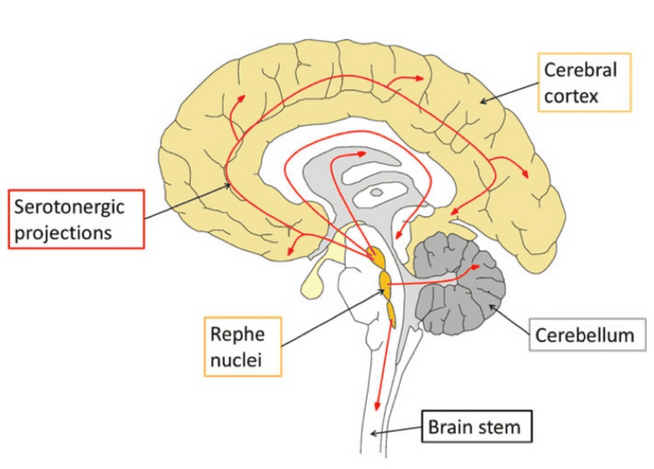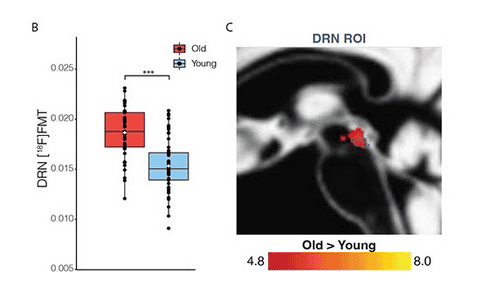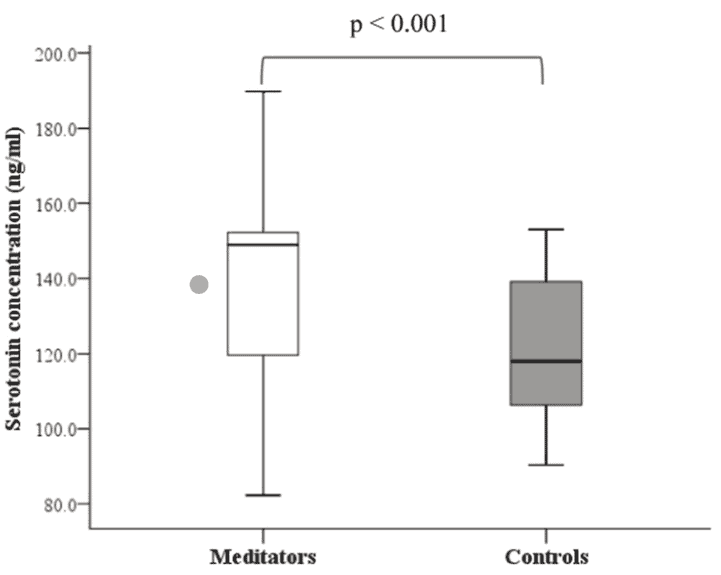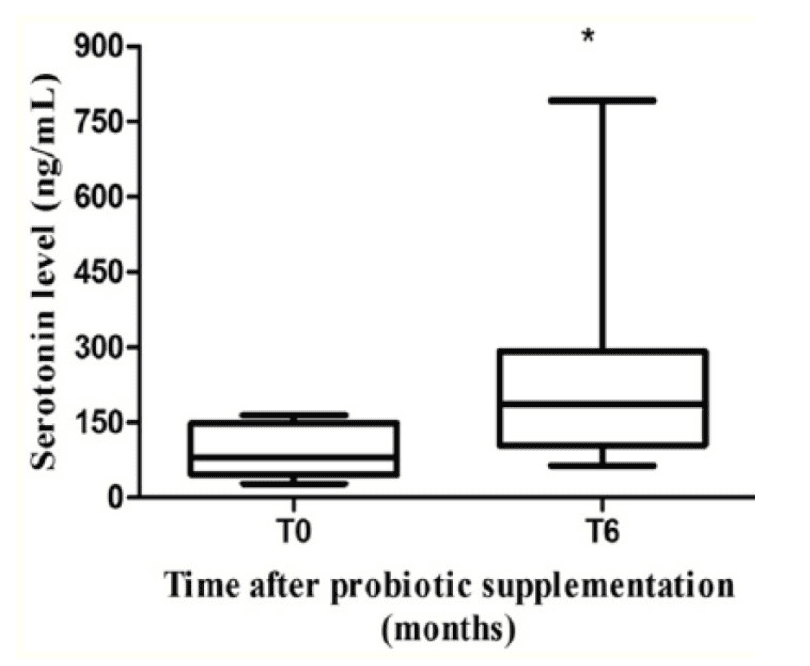
Margaux M. Tolley
MSc (Neuroscience), PgDipSci (Neuroscience), BSc (Neuroscience)
Serotonin has a role as a neurotransmitter and a hormone. While we often associate serotonin with the brain, the majority of serotonin is actually produced in our gut.
While serotonin is important for mood and sleep, and has a potent impact on depression and anxiety, it also influences:
- Wound healing
- Bone health
- Sexual health
This is why it’s important to know how to maintain healthy levels of serotonin and how to prevent actions and activities that might severely deplete it.
What is Serotonin?
Serotonin, or 5-hydroxytryptamine (5-HT), is one of many thousands of neurotransmitters produced within the human body.
Neurotransmitters are chemical communicators within the nervous system, and it is how neurons signal to one another.
Serotonin gained popularity as a target for neuropsychiatric disorders such as major depression and anxiety disorder, but has many roles in the body including:
- Sleep
- Bowel motility
- Cardiovascular function
- Learning
- Memory
- Stress response
Where is serotonin produced?
Around 95% of the body’s serotonin is produced in the gut by enterochromaffin cells (ECCs). Overflow of serotonin produced by ECCs is taken up by platelets and the gastrointestinal lumen.[1]
Serotonin produced by ECCs interacts with extrinsic nerves and projections of intrinsic primary afferent neurons which are involved in gastrointestinal motility and relaying sensations of nausea or discomfort to the central nervous system.[2]
Serotonin produced in the gut or outside of the central nervous system, meaning the brain and spinal column, cannot cross the blood-brain barrier.
Around 95% of serotonin is produced in the gut
In the central nervous system, serotonin is produced by serotonergic neurons located in the brainstem region called the raphé nuclei.
Neurons from the raphé nuclei make connections to many regions including areas of the forebrain and the spinal cord.[3,4,5]

This widespread connectivity demonstrates serotonin’s role in the central nervous system including movement, sleep-wake cycles, mood regulation, and memory.
How is serotonin produced?
Serotonin is synthesized by the metabolism of the essential amino acid tryptophan, by tryptophan hydroxylase (TPH) and L-aromatic acid decarboxylase.[1]
Serotonin is synthesised from amino acid tryptophan
Tryptophan comes from our diet and is needed for serotonin production. This means, if we do not eat enough foods containing tryptophan, serotonin cannot be produced.
Which foods to eat for healthy levels of serotonin?
Luckily, tryptophan is present in many of the foods we consume daily, so it is easy to meet our daily intake. Both plant and animal proteins contain tryptophan, these include:
Food Category | Examples | Tryptophan (mg per 100g) |
Meat and poultry | Chicken, Pork, Beef, Turkey | 200-350mg |
Fish | Cod, Salmon, Tuna | 250-300mg |
Soy and nuts | Peanuts, Almonds, Cashews, Tempeh, Tofu | 150-300mg |
Dairy products | Milk, Cheese, Yoghurt | 100-200mg |
Eggs | 150-200mg | |
Grains | Quinoa, Oats, Buckwheat | 50-100mg |
How do serotonin levels change as we age?
There is a decrease of serotonergic activity that occurs within the central nervous system during healthy ageing. Ageing is impacted by our genetics and also largely by our habits such as:
- Smoking
- Eating
- Exercise
- Sleep
which accumulate their effects later in life.
RELATED — Why we sleep: The role of sleep in our healthy life
Due to the diverse role that serotonin plays within the body, determining the impact of decreased serotonergic activity and the reason for the decrease, is not fully understood and requires more research.
However, a decline of serotonergic activity would coincide with some of the behavioural changes in the older population such as memory loss, depressive behaviours, and altered sleep patterns.
The following studies on age-related changes to the serotonergic system include below.
Neuronal connectivity
This specifically focuses on the dorsal raphé nucleus, a major area of serotonin synthesis, where reduction in connectivity and loss of volume loss has been observed.[6,7]
Markova et al. (2023) found an increase in serotonin synthesis capacity in older individuals compared to young (18-85). This potentially suggests that measurement of serotonin synthesis within the raphé nuclei could be indicative of ageing trajectory.


Receptors and transporters
Studies in humans have shown an age-related decline of presynaptic serotonin transporters in the brainstem.[8]

There were no observed differences between the sexes; open dots are male and closed dots are female.
Serotonin has roughly 14 distinct receptor types present throughout the central nervous system. Less serotonin transporters means serotonin activity may be prolonged, but the effect of this requires further investigation.
Stress responses
Yamaguchi et al. (2016) demonstrated altered stress responses in aged rats compared to young rats by altered TPH expression.[9]
Yamaguchi et al. (2016) found non-stressed older rats had higher TPH expression in the different nucleus of the raphé nuclei (dorsal, ventral, and lateral) compared to young rats.
Following stressor, the younger rats had significant increase in all regions of TPH expression but only in the ventral area in older rats. There was no significant difference in expression between young and old rats following stressor.[9]
Serotonin plays a crucial role in regulating the hypothalamic-pituitary-adrenal axis, which controls our reaction to stress. As we age, alterations to serotonin synthesis, receptors, and transporters impairs our ability to regulate the hypothalamic-pituitary-adrenal axis.
Dysfunction of this axis can increase cortisol and prolong stress, which is associated with anxiety and depression in older individuals. Additionally, the diminished serotonergic function may compromise the brain’s ability to modulate emotions effectively, further contributing to the altered stress response observed with aging.
These studies suggest that the serotonin system does demonstrate age-related changes. More studies need to be conducted to elucidate the exact effects these changes have and preventative measures we can take to slow down the process.
Oxidative stress has been linked to serotonin depletion and ageing.[10] Arivazhagan and Panneerselvam (2002) found that strong antioxidants, such as DL-alpha-lipoic acid, restored serotonin levels in aged rats.[11]
Depressed individuals also exhibit increased oxidative stress, and treatment with selective serotonin reuptake inhibitors (SSRIs) has been shown to reduce it.[6,12]
SSRIs block serotonin transporter, extending the time serotonin is in the synaptic cleft, meaning it is more likely to bind to post-synaptic receptors.[13] Goldberg et al. (2004) demonstrated that SSRIs can compensate for age-related serotonergic decline in the cerebral cortex.[14] However, serotonin transporter levels remain stable in some regions, such as the frontal cortex.
While SSRIs can be effective, there are also natural ways to support serotonin levels without pharmaceutical intervention.
Why is it important to keep serotonin levels balanced?
Too much serotonin or too little has a range of effects on both our physical and mental well-being. Increasing serotonin may not be necessary and should always be under recommendation from a medical professional.
Increasing levels of serotonin puts an individual at risk of developing serotonin syndrome. Serotonin syndrome can affect:
- blood pressure
- tremors
- mood changes
- muscle rigidity
- hot flashes
and other unwanted side effects.
Severe serotonin syndrome may require help from a medical professional and hospital treatment. If you are prescribed any medication that will alter serotonin signalling, the medication should be taken as advised by your doctor.
Low serotonin levels are associated with numerous psychological symptoms and mental disorders, including:
- Post-traumatic stress disorder (PTSD)
- Obsessive-compulsive disorder (OCD)
- Anxiety
- Major depression disorder
- Insomnia
Low serotonin levels can be caused by chronic stress, hormonal changes, digestive issues and certain drugs.
Low serotonin levels can be caused by chronic stress
Severely low levels of serotonin can be due to genetics or low levels of molecules used to generate serotonin such as vitamin B6 or tryptophan.
RELATED — Vitamin B6 (Pyridoxine)
How to increase serotonin levels?
Since serotonin cannot cross the blood-brain barrier, antidepressants pharmacologically target serotonin activity downstream.
Pharmaceutical drugs
Antidepressants that target serotonergic activity include:
- SSRIs
- Tricyclic antidepressants
- Monoamine oxidase inhibitors
- Serotonin-norepinephrine re-uptake inhibitors
Antidepressants work to increase serotonergic activity by increasing availability of serotonin, reducing the breakdown of serotonin, and increasing responsiveness of certain receptors.
Exposure to sunlight
Studies have shown there is a relationship between serotonin levels and light exposure. As we progress through the seasons, daylight exposure changes with the peak in summer and lowest in winter.

Praschak-Rieder et al. (2008) has shown that brain serotonin transporter binding has an inverse relationship with the duration of sunlight, rising and falling in opposition to sunlight exposure in six different brain regions.[15]
Increased serotonin transporter binding means there is less serotonin activity, and in all six regions the highest activity was during the months with the least amount of sunshine.
Health-promoting diet (tryptophan-containing foods)
We need to consume foods that contain tryptophan as our body cannot produce it naturally. Determining the extent dietary tryptophan raises serotonin levels clinically needs further investigation.
Poor diet and dietary dysfunction are implicated in many mood disorders. Tryptophan is more bioavailable in animal based protein compared to plant protein. However, despite differences in bioavailability, a well-balanced diet that includes a variety of protein sources, vegetables, and complex carbohydrates should provide adequate tryptophan levels and is beneficial to overall health outcomes.
Tryptophan is more bioavailable in animal based protein compared to plant protein
Lee et al. (2002) demonstrates that increasing dietary TRP results in increased serotonin and an even larger increase when combined with supplementary B6, which also has a role in serotonin synthesis as discussed below.[16]
Meditation
Meditation is a well known mindfulness practice. It involves focus and sitting with oneself in the present moment with an awareness of your surroundings. Studies have shown meditation has various benefits to those who practice.

Thambyrajah et al. (2023) found that long-term Vipassana meditators had significantly higher levels of serotonin compared to those who do not and have never practiced meditation.
The median serotonin serum concentration was 149.0 ng/ml in the meditators group, while control was 118.1 ng/ml.[17]
Exercise
Regular exercise is proposed to have antidepressant effects. Exercise increases tryptophan in the central nervous system by increasing muscle uptake of branched-chain amino acids that normally compete to cross the blood-brain barrier.[18,19]

Zimmer et al. (2016) demonstrated a linear increase in serum serotonin levels following a bout of exercise in three different intensity groups (low, medium, and high) compared to control non-exercise group. However, the only statistically significant increase of serum serotonin was between the control group and the high intensity exercise group.[20]
Supplements
Tryptophan converts into 5-HTP, then serotonin, with tryptophan hydroxylase controlling the slowest step. Supplementing 5-HTP may bypass this, potentially boosting serotonin.
Vitamin B6 aids 5-HTP’s conversion to serotonin, making it another supplement of interest for mood regulation. However, research is needed to determine proper dosages, duration, and effectiveness for conditions like depression. Consulting a medical professional before taking 5-HTP or B6 is essential to ensure they suit your needs.

Corano Scheri et al. (2017) demonstrated probiotic treatment for six months increased serum serotonin levels.[21]
Yoon et al. (2023) found following a stressor, participants who took ginseng had a significantly smaller drop in serotonin and significantly smaller increase in cortisol compared to the control group.[22]
RELATED — Korean Ginseng (Panax Ginseng)
Ara and Bano (2009) has shown that St. John’s wort increased serotonin and altered serotonin receptor expression in three brain regions following a stressor in rats.[23] Human trials are needed to confirm these findings.
RELATED — St John’s wort (Hypericum perforatum)
In the long term, the most beneficial way to potentially increase serotonin is to have a healthy and diverse diet. Combined with exercise, not only is this beneficial for increased serotonin production, but for healthy aging, immune response, and good sleep.
Serotonin has a diverse function in the body, from gut to central nervous system. It plays a role in our daily function. Abnormalities in serotonergic activity can have major impacts on our lives.
The age-related decrease in activity and signalling coincides with many of the symptoms we experience as we age. Serotonin has potential as an anti-aging target, but this requires further investigation.
Related Questions
1. What is the difference between dopamine and serotonin?
Serotonin is produced in raphé nuclei and imbalances in levels are related to depression, OCD, and anxiety.
Dopamine is produced in the substantia nigra, ventral tegmental area, and hypothalamus, and imbalances in levels are associated with ADHD, addiction, and Parkinson’s disease.
2. What drains serotonin the most?
| Pharmaceutical drugs | Health Conditions | Lifestyle |
| Antidepressants Recreational drugs Oral contraceptives [24] | Long COVID-19 [25] Hormone changes IBS with constipation [26] | Low tryptophan intake Lack of sunlightChronic stress Poor diet (processed foods, high sugar) Poor sleep |
3. What drinks release serotonin?
Caffeine: briefly boosts serotonin, but depletes B6, increases cortisol, triggering serotonin uptake.[27]
Milk: contains tryptophan, potentially increasing serotonin.
Turmeric tea: Curcumin may protect serotonin levels.[28]
RELATED — Turmeric (Curcuma longa)
Fermented drinks: May influence gut serotonin.[29]
Margaux is a neuroscientist with a strong academic background and hands-on experience in research, specializing in muscle physiology, electrophoresis, and protein analysis. Her Master’s research focused on identifying key protein…
If you would like to learn more about Margaux, see Expert: Margaux M. Tolley.
References
(1) Keszthelyi, D., Troost, F.J. and Masclee, A.A.M. (2009). Understanding the Role of Tryptophan and Serotonin Metabolism in Gastrointestinal Function. Neurogastroenterology & Motility.
(2) Gershon, M.D. and Tack, J. (2007). The Serotonin Signaling System: from Basic Understanding to Drug Development for Functional GI Disorders. Gastroenterology.
(3) Hensler, J.G. (2012). Chapter 15 – Serotonin. ScienceDirect.
(4) Walker, E.P. and Tadi, P. (2020). Neuroanatomy, Nucleus Raphe. https://www.ncbi.nlm.nih.gov/books/NBK544359/
(5) Fidalgo, S., Ivanov, D.K. and Wood, S.H. (2012). Serotonin: from Top to Bottom. Biogerontology.
(6) Ikuta, T., Matsuo, K., Harada, K., Nakashima, M., Teruyuki Hobara, Higuchi, N., Higuchi, F., Otsuki, K., Shibata, T., Toshio Watanuki, Matsubara, T., Yamagata, H. and Watanabe, Y. (2017). Disconnectivity between Dorsal Raphe Nucleus and Posterior Cingulate Cortex in Later Life Depression. Frontiers in Aging Neuroscience.
(7) Markova, T.Z., Ciampa, C.J., Parent, J.H., LaPoint, M.R., D’Esposito, M., Jagust, W.J. and Berry, A.S. (2023). Poorer aging trajectories are associated with elevated serotonin synthesis capacity. Molecular Psychiatry.
(8) Christopher, Malison, R. T., Seibyl, J., Laruelle, M., Klumpp, H., Zoghbi, S. S., Baldwin, R. M., & Innis, R. B. (2000). Age-related decline in central serotonin transporter availability with [123I]β-CIT SPECT. Neurobiology of Aging. https://www.sciencedirect.com/science/article/pii/S0197458000001524?via=ihub
(9) Yamaguchi, N., Nakajima, N., Okada, S., & Yuri, K. (2016). Effects of aging on stress-related responses of serotonergic neurons in the dorsal raphe nucleus of male rats. Neurobiology of Stress. https://www.sciencedirect.com/science/article/pii/S2352289515300242
(10) Kesidou, E., Theotokis, P., Damianidou, O., Boziki, M., Konstantinidou, N., Taloumtzis, C., Sintila, S.-A., Grigoriadis, P., Evangelopoulos, M.E., Bakirtzis, C. and Simeonidou, C. (2023). CNS Ageing in Health and Neurodegenerative Disorders. Journal of Clinical Medicine. https://pmc.ncbi.nlm.nih.gov/articles/PMC10054919/
(11) Arivazhagan, P., & Panneerselvam, C. (2002). Neurochemical Changes Related to Ageing in the Rat Brain and the Effect of DL-alpha-lipoic Acid. Experimental Gerontology.
(12) Khanzode, S.D., Dakhale, G.N., Khanzode, S.S., Saoji, A. and Palasodkar, R. (2003). Oxidative damage and major depression: the potential antioxidant action of selective serotonin re-uptake inhibitors. Redox Report.
(13) Chu, A. and Wadhwa, R. (2023). Selective Serotonin Reuptake Inhibitors. https://www.ncbi.nlm.nih.gov/books/NBK554406/
(14) Goldberg, S., Smith, G.S., Barnes, A., Ma, Y., Kramer, E., Robeson, K., Kirshner, M., Pollock, B.G. and Eidelberg, D. (2004). Serotonin modulation of cerebral glucose metabolism in normal aging. Neurobiology of Aging.
(15) Praschak-Rieder, N., Willeit, M., Wilson, A. A., Houle, S., & Meyer, J. H. (2008). Seasonal variation in human brain serotonin transporter binding. Archives of General Psychiatry, 65(9), 1072–1078. https://jamanetwork.com/journals/jamapsychiatry/fullarticle/210137
(16) Lee, N.S., Muhs, G., Wagner, G.C., Reynolds, R.D. and Fisher, H. (2002). Dietary pyridoxine interaction with tryptophan or histidine on brain serotonin and histamine metabolism. Pharmacology Biochemistry and Behavior.
(17) Thambyrajah, J., Dilanthi, H., Handunnetti, S. and Dissanayake, D. (2023). Serum melatonin and serotonin levels in long-term skilled meditators. EXPLORE.
(18) Heijnen, S., Hommel, B., Kibele, A. and Colzato, L.S. (2016). Neuromodulation of Aerobic Exercise—A Review. Frontiers in Psychology. https://www.frontiersin.org/journals/psychology/articles/10.3389/fpsyg.2015.01890/full
(19) Melancon, M.O., Lorrain, D. and Dionne, I.J. (2014). Changes in markers of brain serotonin activity in response to chronic exercise in senior men. Applied Physiology, Nutrition, and Metabolism. https://www.researchgate.net/publication/264832646_Changes_in_markers_of_brain_serotonin_activity_in_response_to_chronic_exercise_in_senior_men
(20) Zimmer, P., Stritt, C., Bloch, W., Schmidt, F.-P., Hübner, S. T., Binnebößel, S., Schenk, A., & Oberste, M. (2016). The effects of different aerobic exercise intensities on serum serotonin concentrations and their association with Stroop task performance: a randomised controlled trial. European Journal of Applied Physiology.
(21) Corano Scheri, G., Fard, S. N., Schietroma, I., Mastrangelo, A., Pinacchio, C., Giustini, N., Serafino, S., De Girolamo, G., Cavallari, E. N., Statzu, M., Laghi, L., Vullo, A., Ceccarelli, G., Vullo, V., & d’Ettorre, G. (2017). Modulation of Tryptophan/Serotonin Pathway by Probiotic Supplementation in Human Immunodeficiency Virus–Positive Patients: Preliminary Results of a New Study Approach. International Journal of Tryptophan Research. https://journals.sagepub.com/doi/10.1177/1178646917710668
(22) Yoon, J., Park, B., Hong, K.-W., & Jung, D.-H. (2023). The effects of Korean Red Ginseng on stress-related neurotransmitters and gene expression: A randomised, double-blind, placebo-controlled trial. Journal of Ginseng Research. https://www.sciencedirect.com/science/article/pii/S1226845323001069?via=ihub
(23) Ara, I., & Bano, S. (2009). St. John’s Wort modulates brain regional serotonin metabolism in swim stressed rats. Pakistan Journal of Pharmaceutical Sciences. https://www.researchgate.net/publication/23938741_St_John%27s_Wort_modulates_brain_regional_serotonin_metabolism_in_swim_stressed_rats
(24) Larsen, S. V., Köhler‐Forsberg, K., Dam, V. H., Poulsen, A. S., Svarer, C., Jensen, P. S., Knudsen, G. M., Fisher, P. M., Ozenne, B., & Frokjaer, V. G. (2020). Oral contraceptives and the serotonin 4 receptor: a molecular brain imaging study in healthy women. Acta Psychiatrica Scandinavica. https://pmc.ncbi.nlm.nih.gov/articles/PMC7586815/
(25) Wong, A. C., Devason, A. S., Umana, I. C., Cox, T. O., Dohnalová, L., Litichevskiy, L., Perla, J., Lundgren, P., Etwebi, Z., Izzo, L., Kim, J., Tetlak, M., Descamps, H. C., Park, S. L., Wisser, S., McKnight, A. D., Pardy, R. D., Kim, J., Blank, N., & Patel, S. (2023). Serotonin reduction in post-acute sequelae of viral infection. Cell. https://www.cell.com/cell/fulltext/S0092-8674(23)01034-6
(26) Cao, Y.-N., Feng, L.-J., Liu, Y.-Y., Jiang, K., Zhang, M.-J., Gu, Y.-X., Wang, B.-M., Gao, J., Wang, Z.-L., & Wang, Y.-M. (2018). Effect of Lactobacillus rhamnosus GG supernatant on serotonin transporter expression in rats with post-infectious irritable bowel syndrome. World Journal of Gastroenterology. https://www.wjgnet.com/1007-9327/full/v24/i3/338.htm
(27) Yokogoshi, H., Tani, S., & Amano, N. (1987). The Effects of Caffeine and Caffeine-containing Beverages on the Disposition of Brain Serotonin in Rats. Agricultural and Biological Chemistry.
(28) Jeong, Y.-I., Kim, S. W., Jung, I. D., Lee, J. S., Chang, J. H., Lee, C.-M., Chun, S. H., Yoon, M. S., Kim, G.-T., Ryu, S. W., Kim, J.-S., Shin, Y. K., Lee, W. S., Shin, H. K., Lee, J.-D., & Park, Y.-M. (2009). Curcumin Suppresses the Induction of Indoleamine 2,3-Dioxygenase by Blocking the Janus-activated Kinase-Protein Kinase Cδ-STAT1 Signaling Pathway in Interferon-γ-stimulated Murine Dendritic Cells. Journal of Biological Chemistry. https://www.jbc.org/article/S0021-9258(19)81784-2/fulltext
(29) Tian, W., Zhao, J., Lee, J.-H., Akanda, M. R., Cho, J.-H., Kim, S.-K., Choi, Y.-J., & Park, B.-Y. (2019). Neuroprotective Effects of Cornus officinalis on Stress-Induced Hippocampal Deficits in Rats and H2O2-Induced Neurotoxicity in SH-SY5Y Neuroblastoma Cells. Antioxidants. https://www.mdpi.com/2076-3921/9/1/27






